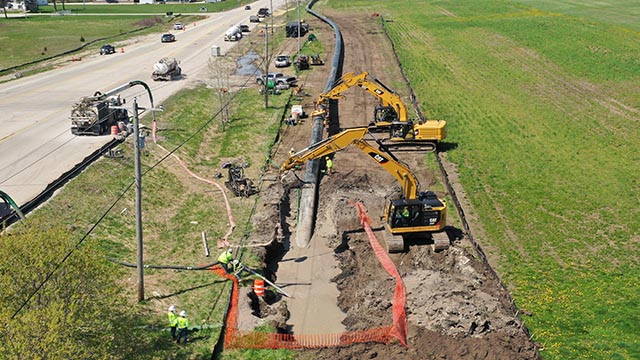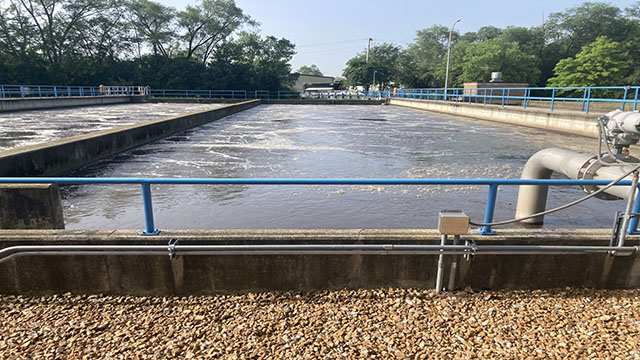It’s finally happening. In a culmination of its deliberate “research, remediate and regulate” strategy, the U.S. Environmental Protection Agency (EPA) issued its final rule regulating PFAS chemicals in drinking water supplies on April 10, 2024.
The final PFAS regulation contains mostly minor changes to the EPA’s 2023 proposed rule. One big change includes a five-year compliance timeline for the maximum contaminant levels (MCL). While this is an improvement from the three years in the proposed MCL, this timeline will still be challenging when considering demonstration testing, design, construction, and procurement of high-demand materials. To meet the challenge, some quick, effective cost and treatment tools are available for consideration. Wherever government and water utilities might fit on the PFAS awareness-action spectrum, the time to address the challenge in earnest is here.
Know the Rule
The final National Primary Drinking Water Regulation (NPDWR) for PFAS monitors six key compounds at the lowest levels ever regulated.
MCLs now are established for perfluorooctanoic acid (PFOA), and perfluorooctanesulfonic acid (PFOS), perfluorononananoic acid (PFNA), perfluorohexane-sulfonic acid (PFHxS), and hexafluoropropylene oxide-dimer acid (HFPO-DA, also known as GenX). The MCLs for PFOA and PFOS are each 4 ng/L, or parts per trillion (ppt). The MCLs for PFNA, PFHxS, and GenX are each 10 ng/L. The EPA also established a Hazard Index (HI) MCL of 1 (unitless) for PFNA, PFHxS, GenX, and perfluorobutanesulfonic acid (PFBS).
The HI is a summation of the individual concentrations divided by the associated health-based water concentration, or the level below which no adverse health effects are likely to occur. The EPA utilized the HI approach due to additive health risk from co-occurrence of these compounds. This HI is only applicable when two or more of these compounds are simultaneously detected.

Compliance with the rule requires public water systems (PWSs) to monitor for these PFAS, notify the public of their PFAS levels, and reduce their levels where they exceed the limits.
Initial Responses
The first concern for most utilities will be monitoring, followed by identifying the cost of compliance if they do exceed the MCLs. The Safe Drinking Water Act (SDWA) requires the EPA to conduct a thorough cost-benefit analysis for every new standard to determine whether the benefits of a drinking water standard justify the costs. Prior to the EPA’s proposed NPDWR for PFAS in 2023, the American Water Works Association (AWWA) contracted with Black & Veatch to provide an independent cost analysis and model the cost of compliance with various regulatory limits and to help inform the regulation. The changes to the EPA’s final NPDWR for PFAS are not expected to impact the compliance costs, given that most systems that would exceed MCLs for PFNA, PFHxS, or GenX would already require improvements due to exceedances in the PFOA/PFOS MCLs. Black & Veatch can use this model to develop compliance costs for individual utilities as well (both capital and lifecycle costs). The cost model enables water systems to develop cost scenarios by accounting for the systems’ unique parameters, from chemical makeup to site constraints, and their impact on possible PFAS mitigation options. Learn more about the cost model.
Without question, compliance with the final rule is a costly proposition; it’s also potentially, a lengthy one. Modular water treatment offers a reliable, cost-effective way to accelerate the compliance process. This solution is most appropriate for capacities from 50 gpm to 8 mgd. Available for rapid and emergency deployment, modular units can be deployed after upfront testing and assessments are complete. Using well-established treatment methods in compact configurations, the systems can be deployed independently as well as in multiple units to handle greater flows. Although temporary, they are a turnkey solution that offers reduced capital investment and a shorter lead time when speed is critical, helping owners relieve regulatory and customer pressure. Explore the benefits of modular PFAS treatment.
No Time to Wait
There is a five-year compliance schedule before the MCLs go into effect under the final rule. PWSs will be required to begin monitoring and reporting within consumer confidence reports (CCRs) within three years. Affected utilities and commercial entities might be tempted to sit tight as the schedule unspools. Not since 1998 has Congress agreed to regulate a new drinking water contaminant, and 2024 as an election year supports a wait-and-see approach.
However, waiting to act should be considered a risky approach, at best. Each primacy agency will consider if an additional two-year compliance “grace period” will be allowed after the 2029 deadline. Even during that grace period, the effects of PFAS regulation under the SWDA will continue to fuel litigation and provide impetus to other EPA efforts to regulate PFAS using the Comprehensive Environmental Response, Compensation and Liability Act (CERCLA) and Resource Conservation and Recovery Act (RCRA). These federal statutes govern management and cleanup of hazardous wastes and materials.
The pressure to understand and mitigate PFAS impacts is significant for other reasons as well. Consider:
The National Academy of Science concurred with the EPA’s findings linking PFOA and PFOS exposure to certain cancers. The allowable exposure level in such instances is typically zero. The SDWA does not allow regulatory limits below the practical quantification levels (PQLs), or levels at which all certified laboratories can accurately measure. For that reason, the MCLs were set at the PQLs.
The science behind the EPA’s final rule is foundational to PFAS regulations that have been and are being implemented across the country at the state and local levels.
Led by the science, the attention by public, media and advocacy groups to PFAS exposure keeps increasing, posing a significant reputational risk to utilities and commercial entities alike.
Also on the rise: legally required reporting and monitoring requirements tracking PFAS use and discharges, with the results available for public (and court) consumption. Examples are the Toxic Release Inventory (TRI) Database, the Unregulated Contaminant Monitoring Rule 5 (UCMR5), and the EPA’s upcoming survey of 400 POTWs to be executed under its Clean Water Act (CWA) authority.
Perhaps the two greatest incentives for acting immediately involve funding and litigation.
Funding & Litigation
Infusion of capital into the water sector via the Infrastructure Investment and Jobs Act (IIJA), also known as the Bipartisan Infrastructure Law (BIL), is accelerating investments in controlling contaminants such as PFAS. The IIJA devotes $10 billion for fiscal years 2022–2026 to addressing PFAS. This is divided into three primary categories: $5 billion to help small and disadvantaged communities address PFAS drinking water issues; $4 billion to help water utilities remove PFAS from drinking water supplies; and $1 billion to help wastewater utilities. All of the IIJA funding for emerging contaminants will be provided as grants or forgivable loans and prioritizes small and disadvantaged communities. The majority of these funds flow through the state revolving fund (SRF) programs, are managed directly by state entities, and are first awarded as formula grants to states before they can flow to recipients implementing projects. This is a two-step process, which results in a one- to three-year delay between when the federal funds are made available by the EPA and when the recipients receive the funds. This means that funds will be available for projects past 2026 and potentially into 2029.
Projects eligible to receive funds include the construction of new treatment facilities or upgrades to existing facilities, planning and design costs, and creation of new community water systems to supply water when privately owned wells or surface water sources are found to be contaminated. Some funds can also be used to pay for activities unrelated to building infrastructure such as household water testing, technical assistance, local contractor training, public communication and water system consolidation.
When it comes to litigation, until recently, only a small number of cases were brought against PFAS manufacturers. Now, the pace and volume of litigation is intensifying. For example, some 13,000 claimants (including dozens of state attorneys general) are participating in a multi-district lawsuit in South Carolina against PFAS manufacturers. Also, bellwether lawsuits against utility companies, energy companies, paper companies and fire equipment distributors are quickly increasing the breadth and depth of PFAS-related litigation. To be able to participate in such litigation, entities must actively, consistently and precisely track their PFAS levels and mitigation efforts.
Needed: Situational Awareness
Utilities and commercial entities need to ensure they can describe the presence or absence of PFAS in their facilities, environs and operations, including inputs and discharges. They also must be able to show they are acting in a manner that protects human health and the environment while complying with all applicable regulations.
Source identification and monitoring (in facilities and their environs), material surveys, discharge surveys and mass balances can all be developed as part of a regulatory compliance or voluntary initiative. Information collected and analyzed on a voluntary basis may be made available to the public or regulators or remain internal for process optimization or under attorney-client privilege. Developing and updating (as appropriate) this situational awareness offers multiple benefits in addition to compliance with EPA’s final NPDWR for PFAS.
Understanding and analyzing real, potential or perceived risks to the public and to facility/utility operations.
Compliance with voluntary monitoring or reporting programs.
Alternative evaluation/feasibility analysis of technology or management strategies.
Preparation for participation in lawsuits (as a claimant, litigant, or defendant).
Preparation to apply for supplemental funding, grants or awards.
Preparation for reaction to federal or state regulatory changes or litigation actions.
Knowledge for input into community relations/stakeholder engagement regarding PFAS issues.
To learn more, visit www.bv.com/pfas or contact our experts today to discuss your specific needs.








